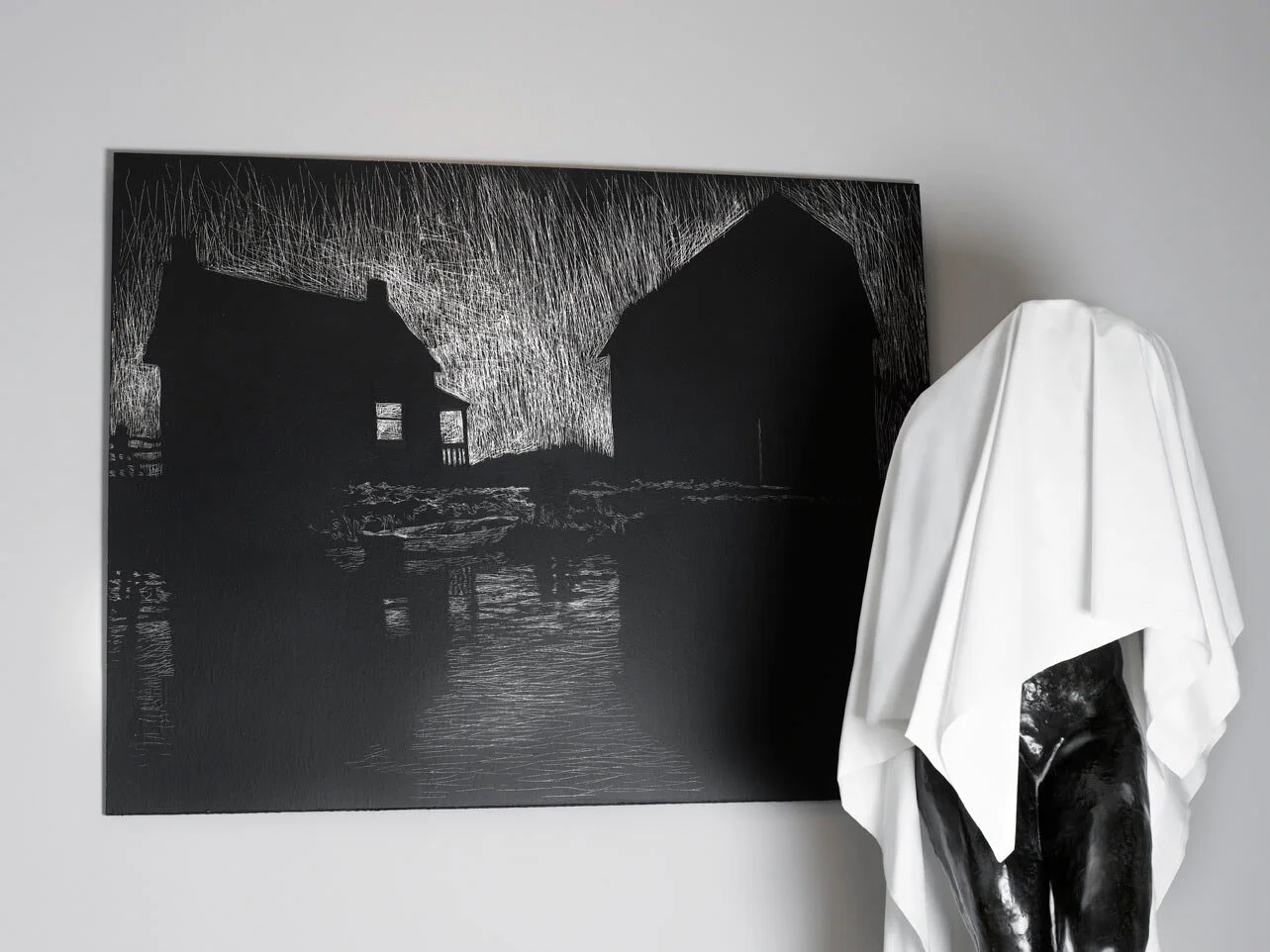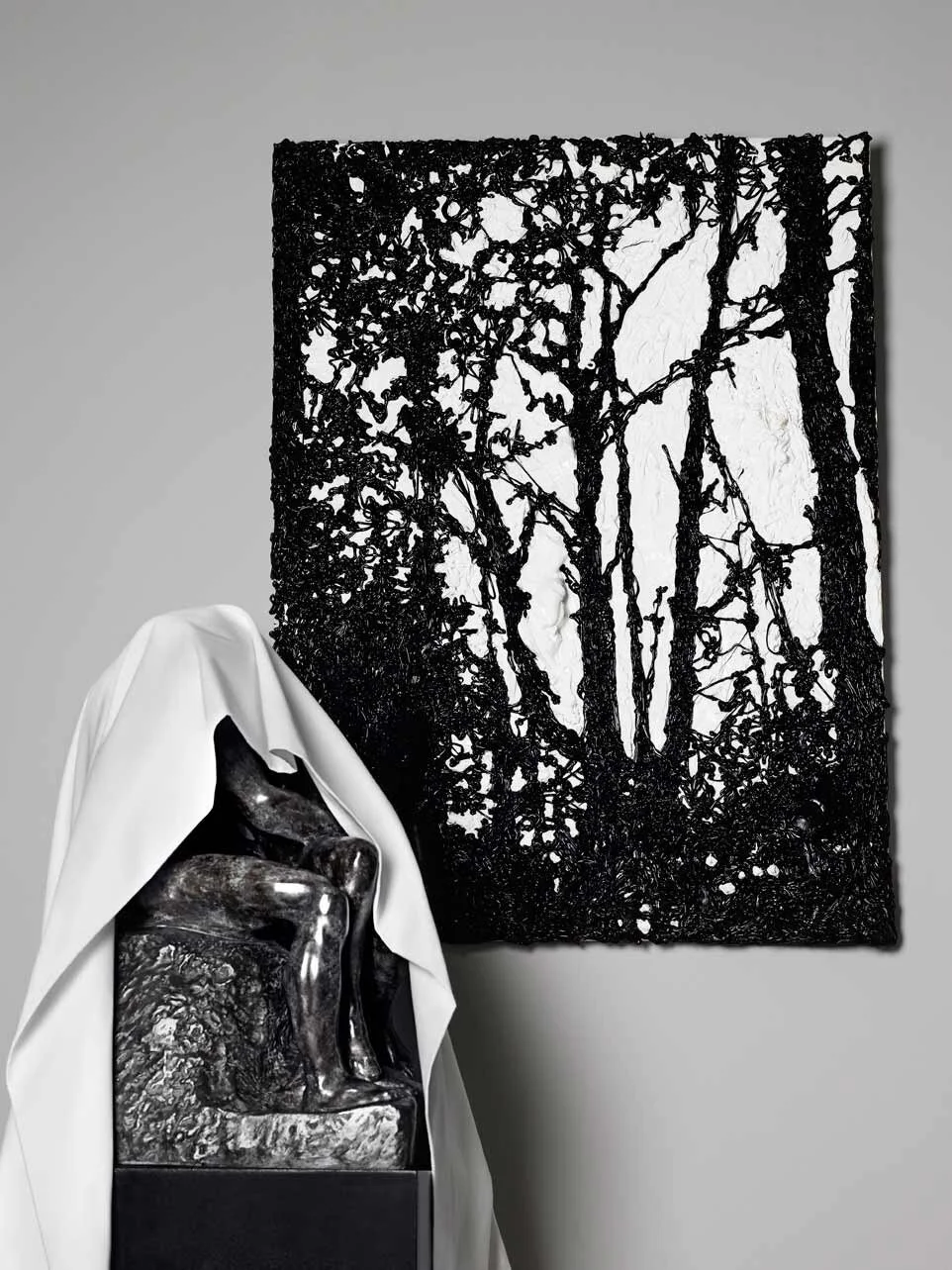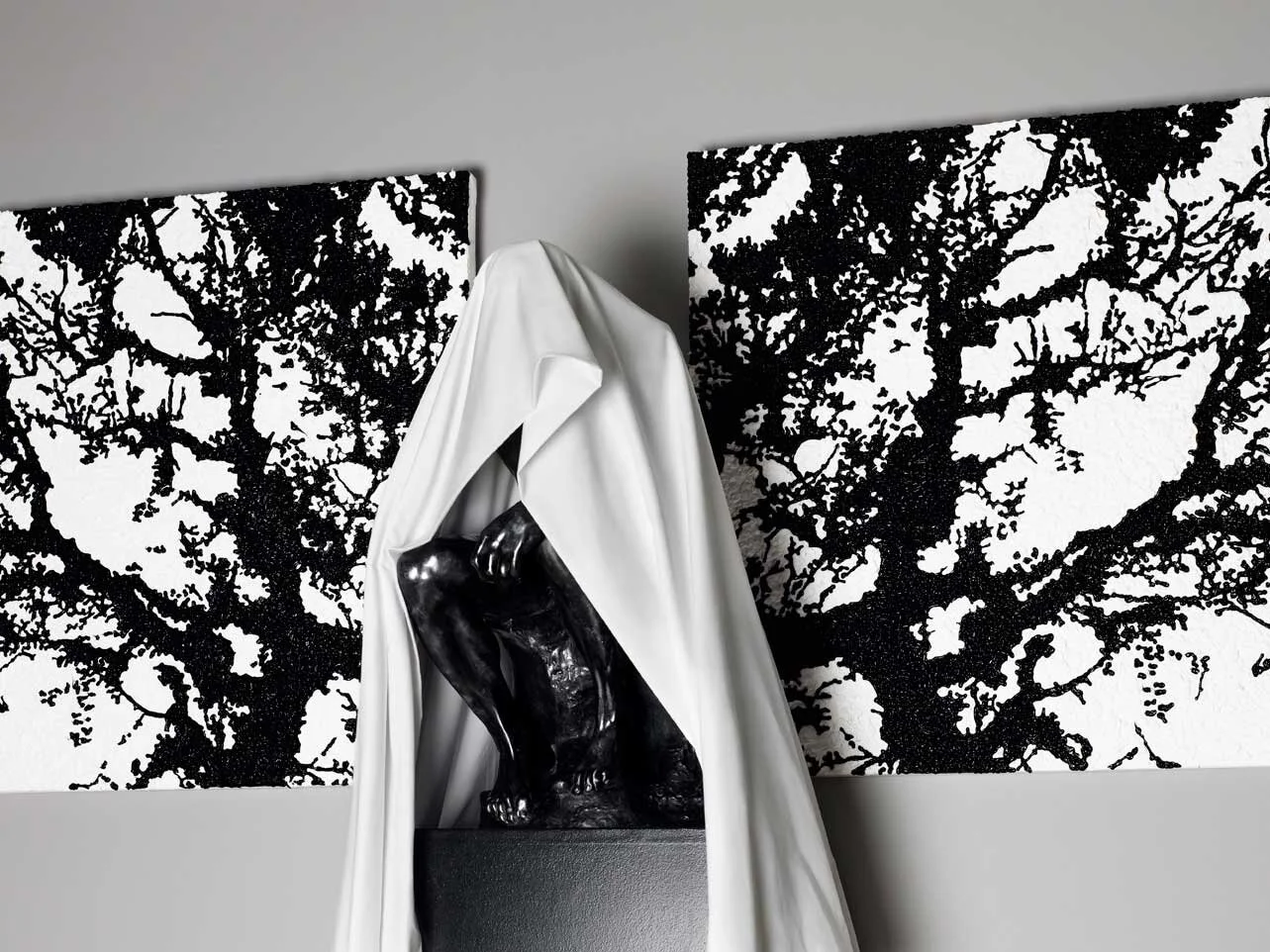Hustler’s Guide to Making it in the Art World: Hustle 1. Your weakness can be your biggest strength
Nicolas Ruston is a visual artist and founder of a design agency. He had zero connections in the art world, zero art education and his family isn’t rich. Despite this he’s managed to have sell out shows in Cork Street and Halcyon Gallery in Harrods. His work appears in major Hollywood Movies and was shortlisted for the European Art Prize. And, in late 2020 his paintings will feature in a motion picture by Danny Boyle and Irvin’e Welsh.
In this series of articles he will explain some of the hustle technique’s he uses to get results.
Hustle 1: Your weakness can be your biggest strength
written by nicolas ruston
It’s easy to look at areas of weakness in your personal development as an artist and let this hinder progress. To make excuses – especially in tough times. To play the blame game, put your feet up and let it all turn to shit. Think about it, you could look back at the pile of burning rubble that was once your art career and say you were at a disadvantage, that the world was cruel. It could be the story you tell yourself about how you nearly made it big and nobody would know any different. Or, you could take action.
I believe that with the right creative techniques and a creative mindset you can use your weakness as a strength to turn a bad situation, a mistake, a personal setback or affliction into something sensational.
There are many cases of artists doing just that. I’d like to give you some examples of artists that have turned a bad situation, personal setback or an affliction into a strength, and how I’ve used this technique when facing challenging situations:
Vincent Van Gogh
When tempers flared between the artist Van Gogh and Paul Gauguin, Van Gogh's illness revealed itself: he began to hallucinate and suffered attacks in which he lost consciousness. During one of these attacks, he used a knife to cut off his own left ear. Following the incident Van Gogh would depict himself in self portraits with a bandage over the side of his face that once sprouted an ear. These paintings are now some of the most well known works in art history.
Now I don’t believe for one moment that Van Gogh was thinking of elevating his personal brand through this gesture of self mutilation, and it certainly didn’t do the penniless post-impressionist any favours at the time. However, as a result of this action, the paintings that depict it, and the notes and letters that have kept his story alive after his death, Vincent Van Gogh has become much more than just a painter. He has become the very image of the ‘tortured artist’, it is his life, depicted, that took him beyond a famous painter and made him a legend.
Billy Childish
Billy Childish is one of the most outstanding, and often the most misunderstood, figures on the British art scene. He’s overcome a number of difficulties and pivoted them to his advantage.
Billy had a difficult past, he was sexually abused as a child, lacked opportunity, had difficulty conforming, was expelled from art school and for years he was an alcoholic. He used all of these past experiences as rocket fuel, as subject matter for a staggering body of work including 3 novels, 100 LP records, over 40 collections of poetry and around 2,500 paintings.
Billy suffers from dyslexia. Now this might seem like a real bummer for anyone else, especially if they aim to be a poet and novelist. Rather than have his poems and novels proofread and corrected, he leaves the mistakes in. They are so much better as a result, they suit his character, align to his raw painting, music and writing style and are also instantly recognisable.
He also co-founded the Stuckest art movement as a result of a negative. The name "Stuckism" was coined in 1999 by Charles Thomson in response to a poem read to him several times by Billy Childish. In it, Childish recites that his former girlfriend, Tracey Emin had said he was "stuck! stuck! stuck!" with his art, poetry and music. This led Thomson to approach Childish with a view to co-founding an art group called Stuckism.
I’m a fan (and collector) of Billy’s paintings. Some people are not so keen. He gets some great write ups as well as some scathing reviews. Rather than hide the negative comments he publishes them alongside the favourable reviews. Again this aligns to his unapologetic, ‘scars and all', approach and adds to the authenticity of his work. Here’s some of the back-jacket reviews from his coffee table book ‘Childish - Paintings of a Backwater Visionary’:
‘I don’t think it is unreasonable to align Billy with figures like William Blake.’
Matt Higgs, Director of White Columns Gallery, NY
‘Britain’s greatest cultural asset.’
The Guardian
‘It’s like he’s never seen a painting before… There's just nothing there.’
Matthew Collings, TV Presenter
‘Billy Childish, one of the greatest influences on my life.’
Tracey Emin, Artist
‘Some of the worst painting I have ever seen on public show.’
The East Anglian Times
Impressionism
Impressionism is a 19th-century art movement characterised by relatively small, thin, yet visible brush strokes, open composition and emphasis on accurate depiction of light in its changing qualities. Impressionism originated with a group of Paris-based artists during the 1870s and 1880s.
But did you know the term impressionism came from a spiteful write up from a critic who thought they were a bit shit. The Impressionists faced harsh opposition from the conventional art community in France. The name of the style stems from the title of a Claude Monet work, Impression, soleil levant (Impression, Sunrise), which provoked the critic Louis Leroy to coin the term in a satirical review published in the Parisian newspaper Le Charivari.
He wrote a scathing review, making wordplay with the title of Claude Monet's Impression, Sunrise (Impression, soleil levant). Titling his article The Exhibition of the Impressionists, Leroy declared that Monet's painting was at most, a sketch, and could hardly be termed a finished work. He wrote “Wallpaper in its embryonic state is more finished than that seascape.”
The term Impressionist quickly gained favour with the public and was also accepted by the artists themselves, a diverse group in style and temperament, that were unified by their spirit of independence and rebellion.
Barry Reigate
When I visited Paradise Row Gallery in 2009 a particular artist’s work caught my eye. The paintings had a cartoon style and controversial themes reminiscent of artists like Jeff Koons. I got into a conversation with the gallerist who told me about the artist - Barry Reigate. He said that his father had spent a lot of time in prison when Reigate was a child, and he used to send him drawings he’d created of crudely rendered Disney characters. These characters now feature in Reigates work. I was impressed that Reigate could tap into this not so ideal situation. And it suits perfectly the themes in Reigate’s work as he frequently highlights hypocrisy that surrounds issues such as sexuality, art, race and class. His cartoon parodies subvert expectations of a medium that carries implicit ideas of innocence.
Propensity Modelling
In 2011 I was offered a solo show at a Mayfair Gallery that represented me, the gallery had its own collection of bronze sculptures by August Rodin. When it came to hanging the show I realised that the Rodins were still in situ and the cost of removing them plus insurance was through the roof. The gallery were happy to support the cost but it would come out of the sale of my works. Now I happen to love his work but I didn’t want his work clashing with the themes I was exploring. So, I went away and thought about it, I researched the Rodin pieces in the gallery collection, and then the penny dropped. I could clearly see the relevance of these works in relation to the themes I was interrogating. I was able to effortlessly weave his work throughout the themes of the show by making a very simple gesture, I partially covered the works in white sheets, revealing only part of the sculpture. This made for a seamless show that incorporated individual pieces, such as The Thinker and The Kiss from his monumental unfinished work The Gates of Hell. It also meant that I could fully explore the dystopian b-movie themes in my work while simultaneously summoning ideas of manipulative theatricality: the narrative control of the entrance of hell.
Nicolas Ruston, Eve next to “How We No Longer Represent How We Are Represented”, 2011
The show was a success and Galleries Magazine described it as "powerful explorations in painting and video of mass media and modern myth.”
Nicolas Ruston, The Kiss next to “Empty And Inescapable Forms Of Seduction”, 2011
In the same show I turned a mistake into a strength, I’d worked with a videographer to create a piece that echoed the paintings. It worked like a symmetrical Rorsach print as you travelled through it there was background noise of digital bird song and an electronic soundtrack that played backwards. The trouble was, that when watched, the film was disorientating and made you feel nauseous. The videographer said he could adjust it so this didn’t happen but I saw this mistake as a brilliant asset, a translation of the uneasy feeling I got when I read the article that sparked the idea for the show, an article about how Japanese and American corporations were buying the patents to DNA sequences. When I’d hung the work, the gallery owner viewed the video, she said “I love it Nick, I love it, I love it, uh, I feel sick!” Mission accomplished.
Nicolas Ruston, The Thinker in between “Sequential Pattern Mining Functions”, 2011
So how do you turn your weakness into your biggest strength?
Here’s nine things you can do:
1. Don’t panic
Don’t have a meltdown, take some deep breaths don’t make instant decisions, instead give yourself some time to think strategically about your next move.
2. Research
Do as much research as you can, interview collectors, gallerists, curators, thought leaders – whoever has insider knowledge you could benefit from. From this information gathering exercise you’ll be able to spot opportunities and trends and plan for the future. This could lead to a new angle, a change of your positioning or a whole new business model.
3. Review the situation
Carry out a SWOT analysis on the current situation and how these factors affect your business. A SWOT analysis is a strategic planning technique used to help a person or organisation identify strengths, weaknesses, opportunities, and threats related to business competition or project planning. Another approach would be to simply make a list of pros and cons.
4. Dedicate time to creativity and innovation
Once you’ve gathered enough information you should dedicate time to creativity and innovation sessions. If creativity isn’t your thing, hire someone to run a creative workshop for you. It can often be really tricky to spot opportunities when you’re inside the thing so unless you are a creative agency and used to running these workshops, I would usually recommend hiring some help.
5. Be authentic
Billy Childish showing bad reviews of his work and publishing his misspellings, Van Gogh painting portraits of his afflictions and Barry Reigate replicating his dad’s prison renderings. All of these examples share a unifying theme: They are authentic. My artistic manager Oliver Squirrell recently interviewed curators Rosalind Davis and Tina Zielger, he asked what they look for in outstanding artists both their answers were identical - ‘Authenticity’. Authenticity, not only in the person and how the person presents themselves but in the work as an original form of expression.
6. Hire an agency, an art management company or an expert
If you want to go that extra mile, and depending on the problem you need solving, you might want to hire a specialist advertising, branding or marketing agency. You can also hire these agencies to work on your personal brand as an artist. For my artistic output I work with Statement Art, they are expert at all the things I’m either not so good at or don’t have time to do, If I did I wouldn’t have any time to make art. When you hire, hire people that are better than you at that particular skill set. You might want to make a list similar to the one below to help you think it through:
Are you the best person at selling your work? No? Hire someone that is.
Are you the best person at managing your long term art career? No? Hire someone that is.
Are you the best person at promoting your work? No? Hire someone that is.
Are you the best person at organising shows? No? Hire someone that is.
Are you the best person at nailing sponsorship deals? No? Hire someone that is.
7. Be like the A-Team
In the 80’s TV show the A-Team, nearly every week, the protagonists would find themselves locked up by the baddies. The baddies were usually really bad at choosing lock ups, it would usually be a warehouse, garage or workshop with some junk and old tools strewn about. The team would quickly get to work, making the best of their situation and working with the limited tools at hand so they could create something that would help them break out to freedom. The point here is you’ll already have a lot of the tools and skills you need to get yourself out of a situation you just need to apply an innovative mindset.
8. Read Who Moved My Cheese
‘Who Moved My Cheese’ is an amusing and enlightening story by Dr Spencer Johnson about four mice who live in a maze and look for cheese to nourish them and make them happy. Cheese is a metaphor for what you want to have in life, for example a good job, a loving relationship, money or possessions, health or spiritual peace of mind. The maze is where you look for it, perhaps the organisation you work in, or the family or community you live in. The problem is that the cheese keeps moving.
In the story, the characters are faced with unexpected change in their search for the cheese. One of them eventually deals with change successfully and writes what he has learned on the maze walls for you to discover. You'll learn how to anticipate and enjoy change, and will be ready to adapt quickly whenever you need to.
9. Get a mentor
I cannot stress how important it is to have mentor, they will be a good person to have around in difficult times. It means you are not working in a vacuum and the person you are asking advice from is at the top of their game.
“But my situation is different” I hear you cry.
“I haven’t got the inclination to lop my ear off, my past wasn’t even that troubled and I’m certainly not the A-Team”. Don’t let this negative internal nay-sayer nag you. Before you dismiss the notion that you can dramatically turn things around. Before you shrug off any possibility that you can view your weakness as a differentiating factor and turn it into a strength that will draw people in. Know that with the right creative techniques and a creative mindset you can quickly and easily turn a bad situation, a defect, personal setback or affliction into something sensational. By following the tips above you’ll soon transform a disadvantage into an advantage.
If you’re still not convinced, ask yourself this:
Would anyone visit the Leaning Tower of Pisa if it was straight?
-
Explore Nicolas’ work via our gallery: statementart.co.uk/gallery/nicolas-ruston
Follow Nicolas on Instagram: @nicolas_ruston
Read Nicolas’ Wikipedia page: wikipedia.org/wiki/Nicolas_Ruston



